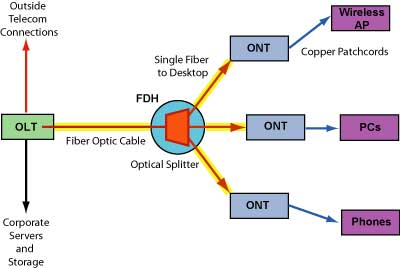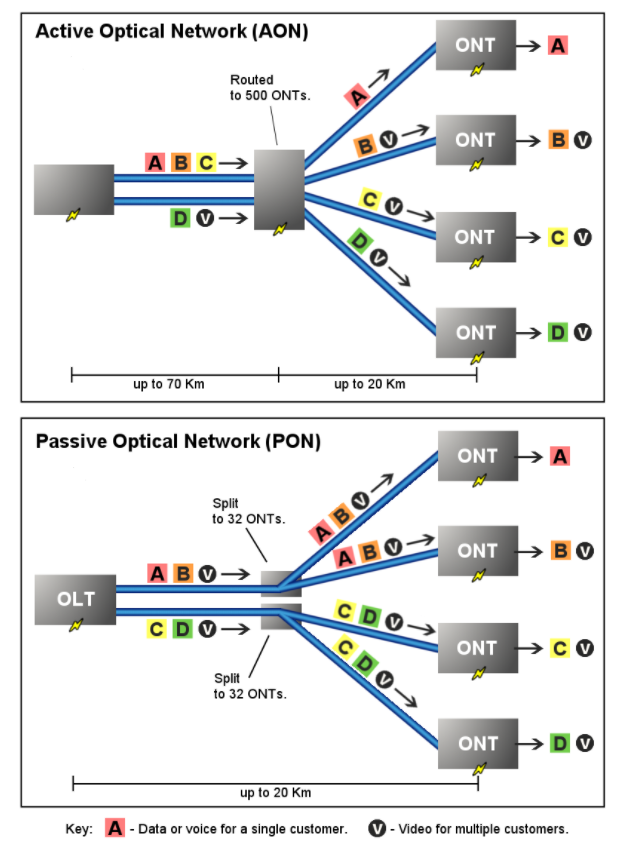
It is universally known that fiber optics transmit data by light signals. As the data moves across a fiber, it needs separated ways to arrive at the targeted places. Generally, there are two essential types to realize it: active optical networks (AON) and passive optical networks (PON). They are both able to provide ways to separate data and route it to the proper places. Nowadays, server providers invest billions of dollars in their access networks to meet the ever-increasing demand for high-bandwidth broadband. In addition to technology longevity, server providers also like to see technology evolution to ensure future consumer demands can be met. Consequently, the development of the network PON type is on the rise.
A passive optical network (PON) refers to a telecommunication technology that implements a point-to-multipoint architecture. In that case, unpowered fiber optical splitters can make a single optical fiber serve multiple end-points such as customers. Then there is no need to connect individual fibers between the hub and the customer. The system can be described as fiber-to-the-curb (FTTC), fiber-to-the-building (FTTB), or fiber-to-the-home (FTTH).

A PON consists of an optical line termination (OLT) and a number of optical network units (ONUs). Normally, the OLT is placed at the server provider’s central office and the ONUs is put near end users. And up to 32 ONUs can be connected to an OLT. The passive optical network simply describes the fact that optical transmission has no power requirements or active electronic parts when the signal is going through the network.
A PON system makes it possible to share expensive components for FTTH. A passive splitter that takes one input and splits it to broadcast to many users, which help cut the cost of the links substantially by sharing, for example, one expensive laser with up to 32 homes. PON splitters are bi-directional, that is signals can be sent downstream from the central office, broadcast to all users, and signals from the users can be sent upstream and combined into one fiber to communicate with the central office.
As it was mentioned above, AON and the network PON type serve as the two main methods of building CWDM and DWDM backbone network. Each of them has their own merits and demerits.
An active optical system uses electrically powered switching equipment, such as a router or a switch aggregator, to manage signal distribution and direction signals to specific customers. This switch directs the incoming and outgoing signals to the proper place by opening and closing in various ways. In such a system, a customer may have a dedicated fiber running to his or her house. The reliance of AON on Ethernet technology makes interoperability among vendors easy. Subscribers can select hardware that delivers an appropriate data transmission rate and scales up as their needs increase without having to restructure the network. However, AON requires at least one switch aggregator for every 48 subscribers. Since it requires power, an active optical network inherently is less reliable than a passive optical network.

As early as the year 2009, the network PONs began appearing in corporate networks. Originally, they were designed to connect millions of homes for telephone, Internet and TV services. Afterward, users adopt these networks for their cheap price, fast speed, low power consumption, easy management, etc. Here, the main benefits of PON are listed below:
Lower network operational costs
Elimination of network switches in the network
Elimination of recurring costs associated with a fabric of Ethernet switches in the network
Lower installation (CapEx) costs for a new or upgraded network (min 200 users)
Lower network energy (OpEx) costs
Less network infrastructure
You can reclaim wiring closet (IDF) real estate
Large bundles of copper cable are replaced with small single mode fiber optic cable
PON provides increased distance between the data center and desktop (>20 kilometers)
Network maintenance is easier and less expensive
Fiber is more secure than copper. It is harder to tap. There is no available sniffer port on a passive optical splitter. Data is encrypted between the OLT and the ONT.
From the above content, we have at least a brief understanding of passive optical networks. In fact, PON has been in the field of telecommunications for many years, and now PON provides customers with the opportunity to deploy new infrastructure. With the development of technology, PON networks are mainly oriented to the commercial market. Especially in the fields of health care, university campuses, hotels, office buildings, etc.Sharetophas been deeply involved in the optical network market for many years and has cooperated with many enterprises, universities and colleges.Sharetop products cover passive optical transmission and active optical transmission, such as optical modules, wavelength division multiplexers, OLTs, etc. Focus onSharetop take you to learn more about optical networks.
